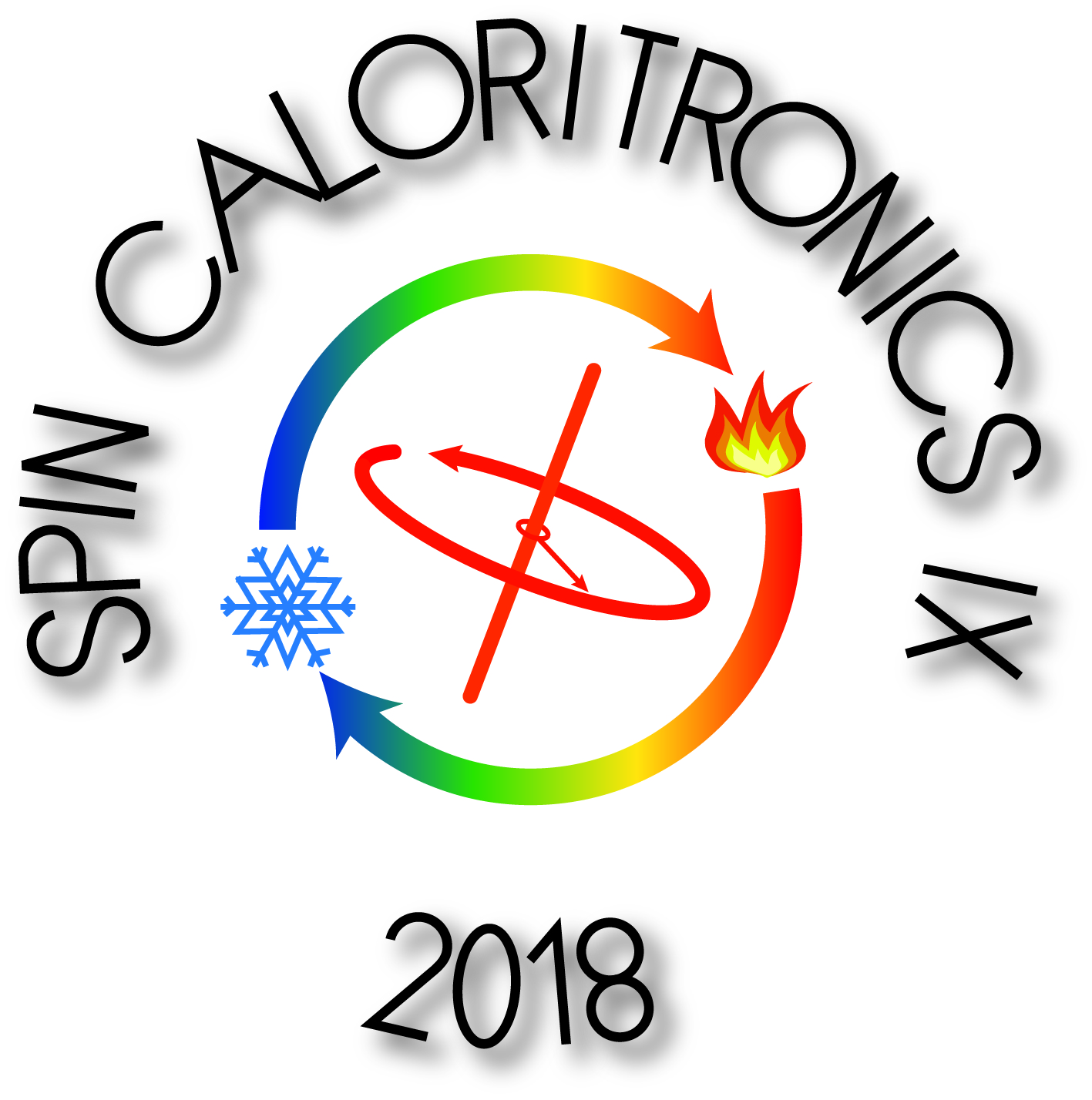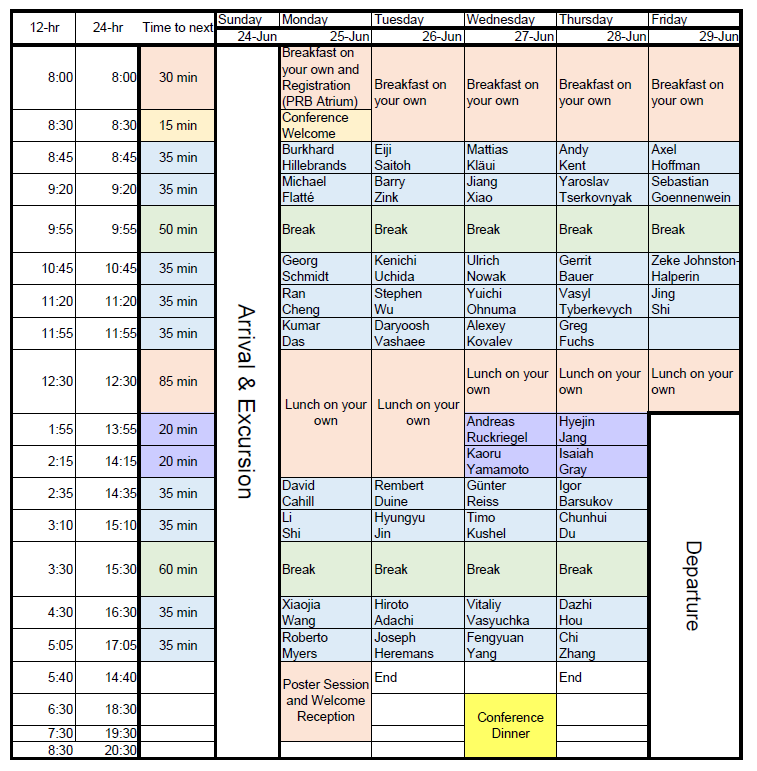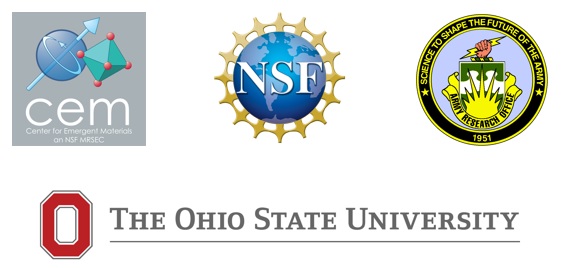Jump to:
Introduction | Topics | Invited Speakers | Venue & Lodging | Program & Abstracts | Schedule
Dates
June 25-29, 2018
Location
The Ohio State University (campus map- location marked)
Physics Research Building
191 W Woodruff Ave
Columbus, Ohio 43210
Description
Spin caloritronics is the study of thermally driven spin fluxes. The community of scientists working on the topic meets annually in a series of Spin Caloritronics workshops. The 9th in the series will be organized at the Ohio State University campus June 25-29, 2018.
Spin caloritronics is a subset of the general study of spin and magnetization dynamics, covering time-dependent, spin-based phenomena and properties, such as spin transport, that are out of thermodynamic equilibrium. Spins can reside on localized electrons in magnetically ordered ferromagnets, ferrimagnets, and antiferromagnets (AFM) that can reside on itinerant electrons in magnetically ordered electrical conductors. In the latter, spin transport accompanies electrical charge transport. Spin residing on localized electrons also can transport magnetization and heat via magnons (spin-precession waves). Research over the last 10 years has emphasized coupled linear transport (Onsager relations) of spin, charge, and entropy by conduction electrons, and charge and entropy by magnons. Spin transport across interfaces between magnetic and non-magnetic materials is of particular interest as the interface breaks the symmetry of the lattice, giving rise to important new phenomena. Spin transfer occurs by a mechanisms called spin-transfer torque, based on the conservation of (spin) angular momentum. Spin transfer torque is the physical principle underlying spin-based memories (MRAM and STT-MRAM), which dominate the Random Access Memory (RAM) market today. Its fundamental study is of the utmost technological relevance for the electronics industry in general, and for the Army in particular.
Spin caloritronics is distinguished by the fact that thermal excitation gives the most intense spin fluxes achievable by any means. It provides a spin flux roughly two orders of magnitude more intense than spin pumping using ferromagnetic resonance, and three orders of magnitude more than electrically pumped fluxes (Spin-Hall magnetoresistance). The field started with the discovery of the spin-Seebeck effect (SSE) in 2008, which was the first new thermomagnetic effect discovered in a century.
At the conference, we expect to see new discoveries from around the world in the following fields, and to discuss future research prospects for the coming decade. Under strong enough driving forces, transport can depart from linearity and new collective spin modes may develop, some of them labeled “Bose-Einstein condensates;” the quest for their observation continues to spur experimental and theoretical activity. Topological effects are not confined to the electron system, but also expected in magnon dispersions. Several new results explore in detail the magnon-phonon interaction, a necessary step to transfer entropy from the phonon system to the magnon system. New results are also expected to be presented on spin transport in antiferromagnets and in chiral structures like skyrmions. AFMs offer new prospects because their spin dynamics are much faster than those in ferromagnets (resonance frequencies are 1 to 2 orders of magnitude higher) and also because the choice of AFM insulating materials is much broader than that of insulating ferromagnets. SSE effects through AFMs have been reported by several groups. Skyrmions are the smallest possible domain-reversal structure, enabling the exploration of the smallest possible magnetic device size. The Dzyaloshinskii-Moriya interaction (DMI) that arises from broken inversion symmetry and spin–orbit coupling, and stabilizes chiral spin structures gives rise to a thermal magnon-Hall effect, which is possibly the only transport property sensitive to it.
Organizers
Prof. Jos Heremans
Prof. P. Chris Hammel
The conference focuses on thermal spin transport, but includes new results in the fields of spin transport and spin dynamics in general.
- Thermal spin transport
- Spin-Seebeck effect
- Magnon-drag
- Magnon-phonon interactions
- Collective spin modes, macroscopic effects
- Thermally-driven macroscopic dynamics
- Other macroscopic dynamics
- Condensation
- Magnon Bose-Einstein Condensation
- Topological effects, Weyl points
- Magnons
- Electrons
- Spin currents through antiferromagnets
- Chiral structures
- Dzyaloshinskii-Moriya interaction
- Skyrmions, heat-induced skyrmion dynamics
- Thermal Hall effects
- Magnetization dynamics
- Insulators
- Metals
Dr. Hiroto Adachi, Okayama University, Japan
Prof. Igor Barsukov, UC Riverside, United States
Prof. David G. Cahill, University of Illinois, United States
Dr. Ran Cheng, Carnegie Mellon, United States
Dr. Kumar, Das University of Groningen, Netherlands
Dr. Chunhui Du, Harvard University, United States
Prof. Rembert Duine, Utrecht University, Netherlands
Prof. Michael Flatte, University of Iowa, United States
Prof. Greg Fuchs, Cornell University, United States
Prof. Sebastian Goennenwein, Technische Universität Dresden, Germany
Prof. Joseph Heremans, The Ohio State University, United States
Prof. Burkard Hillebrands, Technische Universität Kaiserslautern, Germany
Dr. Axel Hoffmann, Argonne National Laboratory, United States
Prof. Hyungyu Jin, Pohang University of Science & Technology, South Korea
Prof. Ezekiel Johnston-Halperin, The Ohio State University, United States
Prof. Mathias Klaeui, Universität Mainz , Germany
Prof. Alexey Kovalev, University of Nebraska, United States
Dr. Timo Kuschel, University of Groningen, Netherlands
Prof. Roberto Myers, The Ohio State University, United States
Prof. Ulrich Nowak, Universität Konstanz, Germany
Dr. Yuichi Ohnuma, University of Chinese Academy of Sciences, China
Prof. Günter Reiss, Universität Bielefeld, Germany
Prof. Eiji Saitoh, Tohoku University, Japan
Prof. Georg Schmidt, U. Halle, Germany
Prof. Jing Shi, UC Riverside, United States
Prof. Li Shi, University of Texas at Austin, United States
Prof. Yaroslav Tserkovnyak, UCLA, United States
Prof. Kenichi Uchida, National Institute for Materials Science, Japan
Prof. Daryoosh Vashaee, NC State, United States
Prof. Xiaojia Wang , University of Minnesota, United States
Prof. Stephen Wu, University of Rochester, United States
Prof. Jiang Xiao, Fudan University, China
Prof. Fengyuan Yang , The Ohio State University, United States
Dr. Chi Zhang, Cornell University, United States
Prof. Barry Zink, University of Denver, United States
Prof. Andy Kent, New York University, United States
Prof. Gerrit Bauer, TU Delft, Netherlands
Workshop Location
Physics Research Building (PRB) map
191 W. Woodruff Ave.
Columbus, OH 43210
Hotel
Blackwell Inn
2110 Tuttle Park Pl
Columbus, OH 43210
Air Travel
The Columbus International Airport (CMH) is approximately 10 miles from Ohio State University.
Final Spin Caloritroincs IX Conference Booklet


This workshop is supported by the Center for Emergent Materials: an NSF MRSEC, Army Research Office, OSU College of Engineering, OSU Institute for Materials Research, OSU Office of Energy and Environment, and OSU Department of Mechanical and Aerospace Engineering
